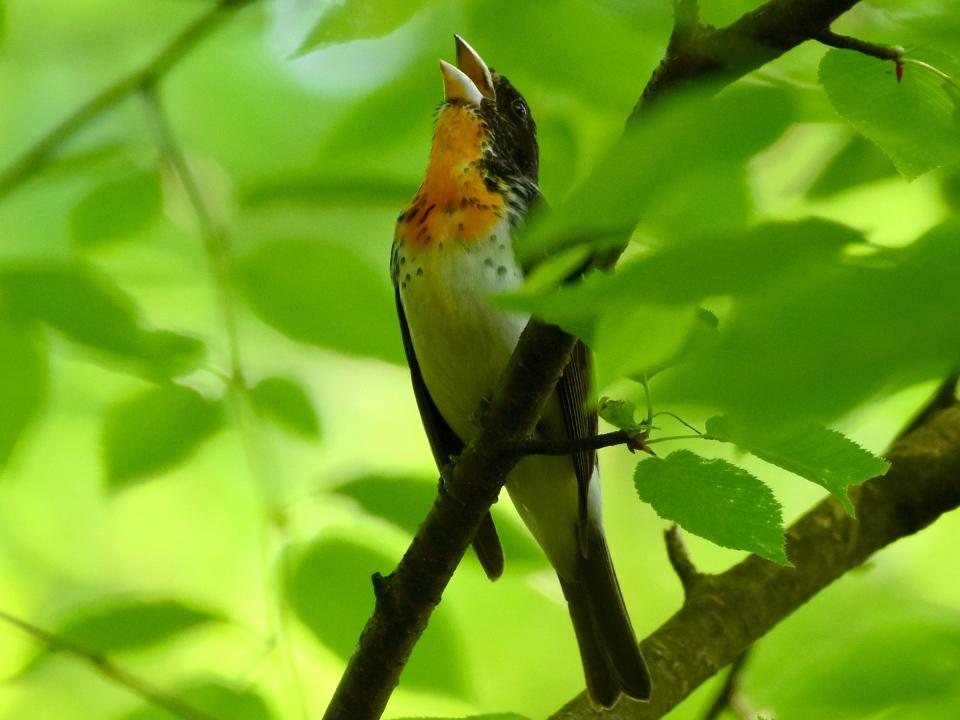Meet the one-of-a-kind 'tanabeak': Researchers identify new songbird hybrid in Pennsylvania
Researchers have identified a new, rare hybrid of two songbirds found in the woods of western Pennsylvania.
The offspring of a rose-breasted grosbeak and a scarlet tanager is the "first-ever documented hybrid of its kind," according to Penn State University. Genetic confirmation of the bird was released in a study published in the peer-reviewed journal Ecology and Evolution Aug. 1.
Self-described "diehard birder" Stephen Gosser first spotted the rare hybrid in June 2020 – when he thought he heard the song of a scarlet tanager. But when Gosser searched for the bird, its appearance did not match.
Instead, he saw what "looked like male rose-breasted grosbeak," the study notes, but with some key differences – including a shallower, more elongated bill and yellowish-white underwings instead of pink.
"The song was basically the first inkling that this was an odd bird," David Toews, assistant professor of biology at Penn State and lead author of the study, told USA TODAY. He also underlined the hybrid's surprising appearance.

"Scarlet tanagers are like bright red ... with black wings. It's hard to miss them," Toews said. "And this was a bird that was a lot paler, a lot of white color and the only red was kind of in the chest area – which is much more like where rose-breasted grosbeak would have it."
Seeing hundreds of hawks flying overhead? How to watch birds this migration season
After locating the bird, Gosser, who is also one of the study's authors, took photos and called for help. A group from the Pittsburgh's National Aviary soon came to get a blood sample from the bird, Penn State's press release says.
Through genomic sequencing and audio of the bird's song, the researchers were able to identify the rare hybrid – as a healthy, 1 -year-old male offspring of a rose-breasted grosbeak and a scarlet tanager.
Does this songbird hybrid have a name?
Naming a hybrid is complicated. In academic literature, Toews notes, the bird is referred to as a hybrid of a rose-breasted grosbeak and a scarlet tanager – or "we would just put a multiplier between the Latin names which is: Pheucticus ludovicianus x Piranga olivacea."
"But it's affectionally most known as like the 'tanabeak,' a mash up of the tanager and grosbeak ... That's my favorite," he added.
How the rose-breasted grosbeak and scarlet tanager got together to create the first known "tanabeak" is a mystery. The two were not previously known to breed, the study said.
Birds flying high, do you know how they feel? New app reveals migration routes, dangers.
The researchers added that the hybrid's parent species are "highly divergent." The two diverged, or last shared a common ancestor, about 10 million years ago, "and thus it is surprising to find a hybrid formed under natural conditions in the wild."
Identifying the parents
While both of the hybrid's parent species exist in much of eastern North America, their habitats differ significantly, Toews adds.
"I'd love to have been a fly on the wall of these two birds to see how and when this went down," he said. "But unfortunately, we only were able to see the result (with their offspring) a year later ... Finding the parents is impossible."
Still, using mitochondrial DNA, the researchers were able to determine that the rose-breasted grosbeak was the hybrid's mother and the scarlet tanager as its father. Mitochondrial DNA is passed to offspring only through the mother, Toews notes.
What do birds eat? Here's what to fill feeders with to bring more birds to your yard.
The audio of the hybrid's song also played a key role, as a process called bioacoustic analysis is needed in lots of bird identification, Toews said. Audio from the field was recorded and put through a digital program so researchers could visualize and measure the sound – to eventually, in this case, confirm the hybrid's song was like that of the scarlet tanager.
Where is the 'tanabeak' now?
The researchers don't know where this individual hybrid is anymore – or whether the "tanabeak" has reproduced.
The natural mortality rate of small, migratory songbirds is also high, Toews said. This hybrid was born in 2019, meaning it's over 3 years old now, if it's still alive, "but we wouldn't expect it to go much longer than three or four years," he said.
"We weren't able to follow it," Toews said. "These are forest birds that are migratory, (it's) not easy to track certain, specific individuals."
But if this hybrid "was able to reproduce, you could imagine it as a bit of a conduit of genes between evolutionarily distinct species," he added. "Over the past decade, we have come to appreciate the role of hybridization in generating novelty and diversity and all the things that we love, in this case, about birds."
It's possible that there could be more hybrids like the "tanabeak" out there, but nothing has been confirmed, Toews said.
What's everyone talking about? Sign up for our trending newsletter to get the latest news of the day
In addition to Penn State, other authors of the study are affiliated with the University of Pittsburgh, the National Aviary, the University of Scranton, Drexel University and the University of New Mexico.
The Institutional Animal Care and Use Committee of the National Aviary and Pittsburgh Zoo and PPG Aquarium approved the research's bird handling.
This article originally appeared on USA TODAY: New bird hybrid of rose-breasted grosbeak, scarlet tanager: 'Tanabeak'


